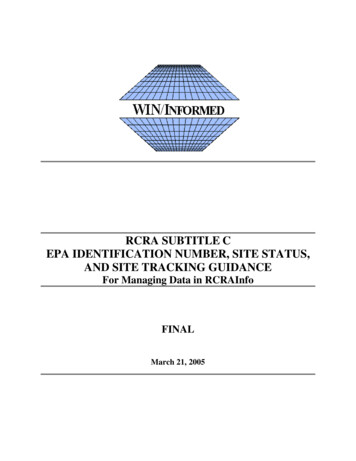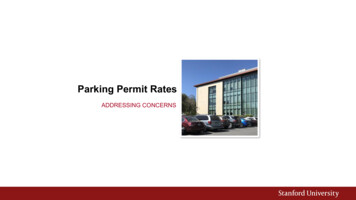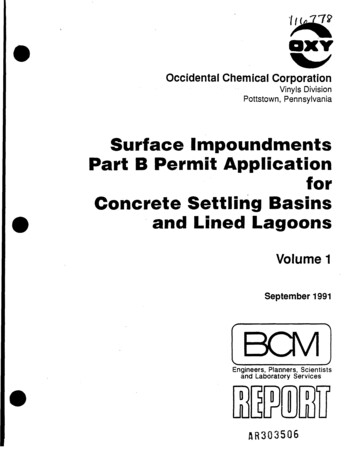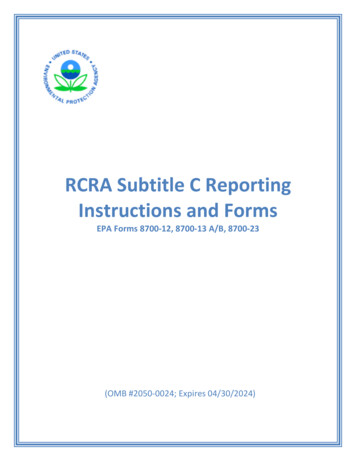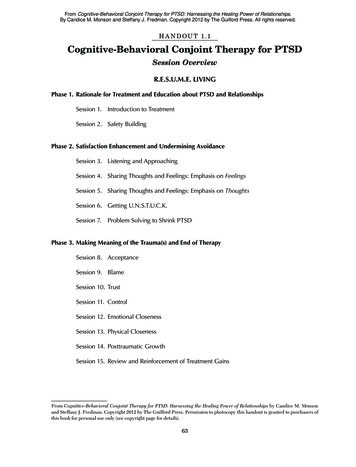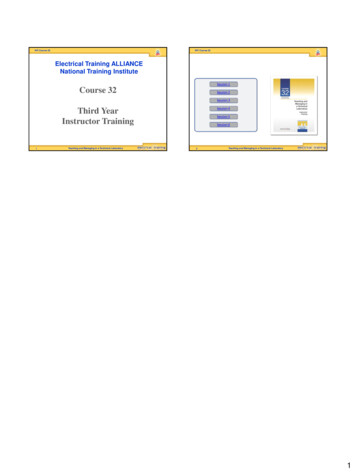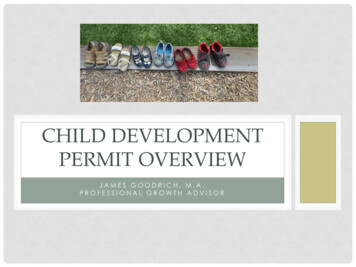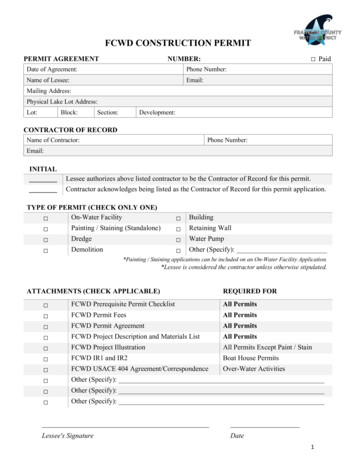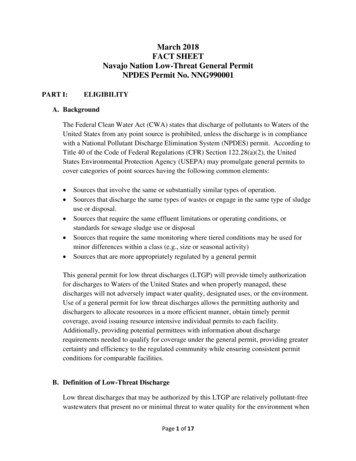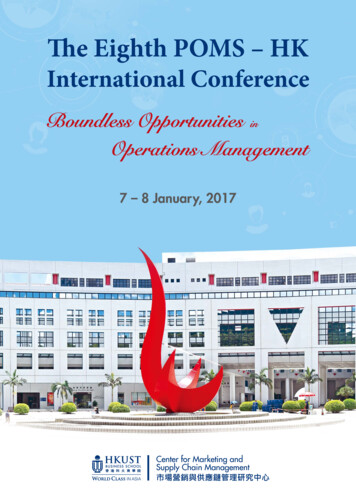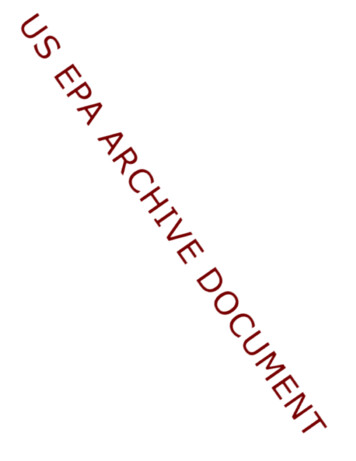
Transcription
SESSION 11RCRA PERMIT TRAINING:REVIEWING THE PERMIT APPLICATION
Session 11 Agenda:Reviewing the Permit Application Introduction Checklist Section H Checklist Section A Checklist Section I Checklist Section B Checklist Section J Checklist Section C Checklist Section K Checklist Section D Checklist Section L Checklist Section E Checklist Section M Checklist Section F Checklist Section N Checklist Section G Checklist Section O
IntroductionPermit ProcessExisting facilitySubmit Part A ApplicationNew or interim status facilityPre-application meetingPart A (new facility) and Part B Application submittedPublish Notice - Part B submittedAdequacy determination of Application
IntroductionPermit ProcessIssue draft permit or intent to deny permitPublic notice – 45 days for commentsPublic hearing if requested or or if any adverse commentsFinal decision and response to comments
IntroductionContents of the Permit Application Overview of the two parts of the permit application:– Part A application - is standard form (Form 8700-23) for reporting basicinformation about the facility and the hazardous waste managementunits– Part B application - contains detailed, site-specific information about thefacility location, hazardous waste management unit design andoperation, and other essential facility operational requirements to ensureprotection of human health and the environment Checklist used to review application for technical adequacy andcompleteness, and prepare Notice of Deficiency Generally conduct a completeness review first, and if completefollow with a review of the technical adequacy
Checklist Section APart A Application General information required in all applications– Form 8700-23– Activities which require the RCRA permit– Location, mailing address, contact info, etc.– Standard Industrial Classification Codes– Waste designation, waste codes– Processes used for treating, storing, disposing of wastes– Listing of all permits applied for or received
Checklist Section BPart B Application General information required in all applications– General facility description (including location information, flood plainand topographic maps, traffic patterns)– Process description (including engineering and structural details,identification of all primary and ancillary equipment, operationalprocedures, monitoring devices/procedures)– Waste characterization– Procedures to prevent hazards (including security provisions,inspections, special waste management practices)
Checklist Section BPart B Application General information required in all applications– Contingency plan– Training plan– Closure plan, post-closure plan, financial requirements– Information on solid waste management units– Compliance with other federal laws– Application certification Unit-specific information required– Design and operational details for each hazardous waste managementunit– Groundwater monitoring system (if required)
Checklist Section BFacility Description General Facility Description Topographic map that shows 1,000 feet around the units and doesnot exceed a scale of 1 inch equals 200 feet General requirements for units– 100 year flood plain– Surrounding land use– Wind rose– SWMU locations
Checklist Section BFacility Description Land disposal facility information– Groundwater flow– Monitoring wells– Point of compliance– Plume locations Seismic requirements– Fault locations if any Flood plain requirements (only if in 100 year flood plain) Traffic Patterns– Number and type of vehicles– Signs and controls– Road surface composition
Checklist Section CWaste characterization Chemical and physical analysis of waste– Data from waste testing Waste analysis plan (WAP)– Parameters and rationale for parameters– Test and sampling methods Unit-specific requirements Additional requirements for off-site facilities Analytical requirements to meet land disposal restrictions (LDR)standards As an alternative, provide documentation of process and generatorknowledge
Checklist Section CWaste characterization Examples of unit specific requirementsContainerizedWastesTank SystemsLandfilled Wastes Land Treatedwastes- Demonstratethat waste iscompatible withcontainermaterials- Demonstratethat waste iscompatible withtank systemmaterial- Demonstratethat sorbentmaterials arenonbiodegradable- Identifyhazardousconstituentsexpected to bein or derivedfrom waste, iffood-chain cropswill be grown intreatment zone
Checklist Section CEPA Test and Sampling Methods SW-846, Test Methods for Evaluating Solid WastePhysical/Chemical Methods– Must reference specific methods– Other references (e.g., ASTM methods) 40 CFR Part 261, Appendix I describes acceptable samplingmethods or may petition for equivalent testing or analytical method(40 CFR 260.21) Sampling methods must be representativeSW-846
Checklist Section DProcess Information – Container Storage Requirements Description of containers (including design information)– Numbers, sizes of containers Container management practices (including procedures fortransferring wastes)– Containers closed and handling procedures– Aisle space and stacking height Container storage area containment (including containment systemdesign, capacity, drainage, control of run-on) Special requirements for ignitable, reactive, or incompatible wastes Response to spills/leakage
Checklist Section DContainer Storage Requirements Compatibility of container with waste– Discussion of location of incompatible wastes and buffer zones forcontainers Free liquid tests Handling to prevent rupture or leakage Reaction temperatures Solidification/stabilization
Checklist Section DProcess Information – Tanks Existing tank system or component– Handled hazardous waste, or installation commenced, prior to July 14,1986 New Tank System or component– Installation commenced after July 14, 1986
Checklist Section DTank Types Aboveground tank - entire surface is completely above plane ofadjacent surrounding surface; entire surface; including bottom, canbe visually inspected Onground tank - bottom of tank on same level as adjacentsurrounding surface; tank bottom cannot be visually inspected Inground tank - base below plane ofground level; not completely buried;portion of tank surface cannot be visuallyinspected Underground tank - entire surface areabelow ground level
Checklist Section DNew Tank Systems Written assessment– Construction design standards– Hazardous characteristics of waste(s)– Corrosion assessment– Protection from damage from vehicular traffic– Foundation conditions Certification of design– Certified engineering drawings– PE certification of installation Proper system installation, testing and procedures– Leak detection operation and maintenance– Over flow and over filling controls
Checklist Section DPerformance Standards for Secondary Containment Design, installation, and operation to prevent migration of wastes orliquids outside of tank system to soil, groundwater, or surface waterat any time during use of system System capable of detecting and collecting releases until materialsremoved (detection within 24 hours, removal within 24 hours ofdetection) Variance from secondary containment requirement– Equivalent protection of groundwater and surface water– No substantial present or potential hazard– No free liquids; location inside building
Checklist Section DOptions for Secondary Containment External liner system Vault Double-walled tank Equivalent device Containment building Variance
Checklist Section DSurface Impoundments Definition– Natural or man-made depression– Constructed primarily of earthen materials– Designed to hold liquid wastes or those with free liquids– Also referred to as pits, ponds, lagoons, etc.
Checklist Section DSurface Impoundments Design and operation– Must have a liner– Liner must prevent migration of any wastes to surrounding soil, groundwater and surface water– Liner must resistChemical attackForces and pressure gradients from operationsPhysical contact with wastesClimate conditions (e.g., sunlight, drying, etc.)Stresses from installation and daily operationsFoundation must support all loads, pressures and movements (uplift andsettlement)
Checklist Section DSurface Impoundments New Impoundments– Part B application received after November 8, 1984– Includes new, replacement and expansion units– Two or more liners required– Leachate collection and removal systems between all liners– All liners meet containment requirements given above Exemption for alternate designs andsome monofills
Checklist Section DWaste Piles Definition– Waste is not "containerized"– Holds "solid," nonflowing wastes– Used for storage or treatment Design and operation– Must have single liner similar to surface impoundments– Leachate collection system above the liner– Run-on and run-off control– Wind dispersion control as needed
Checklist Section DWaste Piles Exemptions for alternate designs, enclosed dry piles, replacementwaste piles, and some monofills New waste piles– Applies to units newly constructed after January 29, 1992– Applies to expansion or replacement piles constructed after July 29,1992– Two or more liners required– Leachate collection and removal system above top liner– Leachate collection and removal systems between all liners– Run-on and run-off control– Wind dispersion control as needed
Checklist Section DProcess Information Examples of unit specific requirementsContainers-Basic designparameters,dimensions andmaterials ofconstructionTank SystemsSurfaceWaste PilesImpoundments (SI)-Dimensions and-A list of wastes to I- A list of wastes tocapacity of each tank be placed in SIbe placed in thewaste pile-Description of feed- Engineeringsystems, safetyplans and report-Detailedcutoffs, bypasson SI design,engineering plans-How designsystemsconstruction,on waste pilepromotes drainageoperations, andconstruction-Diagrams ofmaintenance-Capacity relative to piping,instrumentation-Details of treatmentnumber and volume , and process flowprocess in wasteof containerspiles
Checklist Section DLand Treatment Definition– Waste applied onto or incorporated into the soil surface– Units are considered disposal facilities if the waste will remain afterclosure Design and operation– Must maximize degradation, transformation and/or immobilization ofhazardous constituents within the treatment zone– Demonstrate effectiveness prior to land applicationLab analysesField testsAvailable dataPrior operating data– Run-on and run-off control– Wind dispersion control as needed
Checklist Section DLand Treatment Food-chain crops– Must demonstrate no substantial risk to human health to grow foodchain crops on unit Unsaturated zone monitoring required Special requirements for ignitable, reactive, incompatible, dioxin,furan and LDR wastes
Checklist Section DLandfills Definition– Disposal facility where waste is placed in or on the land– Unit is not aSurface impoundmentWaste pileLand treatment unitUnderground injection wellSalt dome or bedUnderground mine or cave Design and operation– Essentially the same requirements as for surface impoundmentsincluding those for "new" units– Plus run-on, run-off and wind dispersion control
Checklist Section DLandfills Exemptions for alternate designs, replacement units, and somemonofills Monitoring and inspections– Construction Quality Assurance (CQA) program must be developed andimplemented during construction for workmanship and materials– Action Leakage Rate must be identified– Leakage Response Action Plan must be developed
Checklist Section DLandfills (cont’d) Special requirements for– Ignitable and reactive wastes– Incompatible wastes– Bulk and containerized liquids– Containers– "Lab packs"– Dioxin, furan and LDR wastes
Checklist Section DContainment Buildings Definition– New storage and treatment unit added August 18, 1992– A completely enclosed, self-supporting structure designed to containwastes (in essence, an indoor waste pile)– Unlike waste piles, however, these units are not considered landdisposal units in which wastes must meet land disposal requirementsprior to placement– Used for uncontainerized waste storage or treatment– May be used as secondary containment for tank system
Checklist Section DContainment Buildings Design and operation– Must be constructed of man-made materials– Units managing non-liquid wastes only required to have primary barrier– Units managing liquids must have:Primary barrierLiquid collection systemSecondary barrierLeak detection system– Must have fugitive dust control system– Design must be certified by registered engineer Exemptions for certain wastes with limited liquid contents
Checklist Section DIncinerators Definition– Enclosed device– Uses controlled flame combustion– Not a boiler or industrial furnaceUnless the purpose is to destroy the hazardous waste Trial burn requirements– Trial feed based on anticipated concentrations anddifficulty to destroy constituents– Engineering description of incinerator– Sampling procedures, methods, and test protocols– Pollution control equipment operation– Shutdown procedures
Checklist Section DIncinerators Performance standards– For each Principal Organic Hazardous Constituent (POHC)– 99.99% destruction and removal efficiency (DRE) for most POHCs– 99.9999% ("6-nines") DRE for dioxins and furans– Control HCI and particulate emissions Operating requirements– Must operate in accordance with permitFeed type and rateExhaust gasesCombustion parameters– Cannot burn hazardous wastes during start-up and shut-downconditions– Control exhaust and fugitive emissions– Provide automatic waste feed cutoff systems
Checklist Section DBoilers and Industrial Furnaces (BIFs) Boilers are enclosed devices using controlled flame combustion andspecific characteristics (40 CFR 260.10)– Recover and export thermal energy in the form of steam, heated fluid, orheated gases, and the unit combustion chamber must be of integraldesign Industrial furnaces are those designated devices that are an integralcomponent of a manufacturing process that use thermal treatmentto recover material or energy, specifically:– Cement, lime, phosphate and aggregate kilns– Blast, methane reforming, and halogen acid furnaces– Titanium dioxide chloride process oxidation reactors– Coke ovens, smelting, melting, refining furnaces– Pulping liquor recovery furnaces– Combustion devices used in the recovery of sulfur values from spentsulfur acid
Checklist Section DBIFs Permitting process (266.102)– Trial burn plan– Trial burn– Part B permit Operating requirements for BIFs– Analysis and feed rate monitoring of all feed materials– Feed rate limits on hazardous waste– Feed rate limits on metals, chlorine, ash– Air pollution control system operating requirements (if applicable)– Continuous Emissions Monitors (CEMs)– Inspections– Proper operations of automatic hazardous waste feed cut off system– Record keeping provisions
Checklist Section DBIFs Performance standards– 99.99% DRE– 99.9999% Dioxin– Limits on CO and HC in stack gas– Metals, HCL, and chlorine– Particulate matter– Fugitive emissions must be controlled– Testing and risk assessment for dioxins,furans when emissions potential is high– Emission standards (266.104 –266.107)
Checklist Section DSubpart X Units (Miscellaneous Units) Definition of a miscellaneous unit– A hazardous waste management unit where hazardous waste is treated,stored, or disposed of and that is not a container, tank, surfaceimpoundment, pile, land treatment unit, landfill incinerator, boiler,industrial furnace, underground injection well with appropriate technicalstandards under 40 CFR Part 264, containment building, correctiveaction management unit, or a unit eligible for research, development,and demonstration permit under 40 CFR 270.65 Examples of miscellaneous units– Open burning and open detonation grounds– Salt domes– Burn pans
Checklist Section DOB/OD units Open Burning/Open Detonation (OB/OD) Units– Most typical subpart X unit– High potential for impact as usually performed on the ground or intreatment devices that are open to the air Major permitting issues– Definition of “Potential to Detonate”– Containment– Air assessment– Sampling and monitoring requirementsAnalytical issues and detection limitsGroundwater monitoringUnsaturated zone monitoring and soil sampling– OB/OD units on active impact ranges
Checklist Section DOB/OD units Specific Part B general standards such as the Part A, general facilityinformation, procedures to prevent hazards, contingency plan,personnel training, are consistent with the requirement for otherRCRA Part Bs Waste analysis plan– Waste characterization– Test methods, often on-site methods– Subpart X (OB/OD) units are required to evaluate treatmenteffectiveness – (modeling data often required)
Checklist Section DPermitting Requirements Unit description (OB/OD)– Unit (burn pans, burn vaults, etc.)Engineered diagrams and drawing (PE certification)Preparation cover– Inspection, monitoring and maintenance planControl of deterioration of device– Ash and residue managementCollective residues, product ejectionControl of release of ash– Run-on/run-off controlPrevention of accumulation of precipitation
Checklist Section DEnvironmental Performance Assessment Quality and physical and chemical characteristics of waste Hydrogeological characteristic of site Protection of groundwater Protection of surface water, wetlands and soil Air quality assessments Human health and ecological risk assessments– Risks for both existing and future contamination
Checklist Section EGroundwater Monitoring Requirements General monitoring requirements– Specify the point of compliance– Sufficient wells properly located to yield both background groundwaterquality and water quality passing the point of compliance– Consistent sampling/analysis procedures– Determination of groundwater elevations during all sampling periods– Background groundwater quality– Statistical comparison procedures– Any other required monitoring (e.g., vadose zone, air)
Checklist Section EPoint of Compliance Vertical surface located at the hydraulically down gradient limit ofthe waste management area that extends down into the uppermostaquifer underlying the regulated units Waste management area (WMA) includes horizontal space taken upby any liner, dike, or other barrier designed to contain waste in aregulated unit If more than one regulated unit exists, the WMA is an imaginary linecircumscribing several regulated units
Checklist Section EGroundwater Monitoring During Permit LifeGeneral MonitoringProgram tected at point ofcomplianceDetectionComplianceMonitoring ProgramMonitoring ProgramHazardous constituentsexceed conc. limitsbetween POC anddown gradient facilityboundaryCorrective ActionProgram
Checklist Section EGroundwater Monitoring – Contents of a Part B PermitApplication The Part B should include:– Summary of interim status groundwater monitoring data– Identification of aquifers and associated information (e.g., groundwaterflow direction and rate, interconnection of aquifers)– Delineation of waste management area, including the proposed POCand groundwater monitoring system– Description of contaminant plumes (if present)– Groundwater monitoring programSampling and analysis planStatistical methodsContaminants of concern
Checklist Section EGroundwater Monitoring Plan If detection monitoring is warranted, submit analytical parameters,proposed groundwater monitoring system, background data for eachproposed monitoring parameter, sampling/analysis plan If compliance monitoring is warranted, submit information toestablish compliance monitoring program, which may includecorrective action engineering feasibility plan. Also include wastedescription, groundwater contaminant characterization data,analytical suite, proposed concentration limits for each hazardousconstituent, sampling/analysis plan
Checklist Section EGroundwater Monitoring Plan If corrective action program is warranted, sufficient informationshould be submitted to establish a corrective action program (unlessalternate contaminant level (ACL) established), that includescharacterization of contaminated groundwater, contaminantconcentration limits, corrective action plan, description of how themonitoring program will demonstrate the adequacy of correctiveaction, and a schedule for information submittal
Checklist Section FProcedures to Prevent Hazards Security Inspection schedule Equipment requirements Prevention procedures, structures and equipment Procedures for ignitable, reactive and incompatible wastes
Checklist Section FSecurity Security procedures and equipment:– 24-hour surveillance system; OR– Barrier and means to control entryProcedures and personnelLocation and description of equipmentSigns in English, posted at entrances and legible from 25 feet– Must be able to prevent unauthorized entry of persons and livestockEnsure that physical injury from waste will not injure unknowing intruder
Checklist Section FInspection Schedule Inspection schedule for general facility requirements– Items to be inspected (i.e. specific types and numbers of each piece ofequipment, storage locations at the facility for each item)– Types of problems– Frequency of inspection– Remedial actions– Inspection log to document inspection– Inspection schedule is commonly used to ensure (and verify)compliance
Checklist Section FInspection Schedule Examples of items to be inspectedMobile EquipmentTire/tracksBrakesHydraulicsTrailer hitchesLights-running/emergencyHorns/sirensEngine conditionsStructuresDikesBermsRampsLifts (elevators)Tank supportBases/foundationsRoofsWallsAreaLoading areaUnloading areaStorage areaMain roadwaysGates and fencesPeripheryCommunication EquipmentTelephonesRadiosIntercomsPublic address systemTV monitoring systemEmergency EquipmentFire control equipmentPersonal ProtectionEquipmentSpill Control Equipment
Checklist Section FInspections Example of inspection frequencies– Areas subject to spills - daily– Container storage areas - weekly– Tank systems - dailyAbove ground portionOperating dataConstruction materials and surrounding area– Tank systems - schedule to be establishedOverfill control– Tank systemsCathodic protection, within 6 months of installation/annually thereafterCompressed current, bimonthly
Checklist Section FInspections Unit specific requirements– Important that inspection section and process section of thechecklists be cross referenced in order to ensure that the unitstructure, all primary and ancillary equipment, secondarycontainment, monitoring equipment, and all unit specific safetyequipment is accounted for in the inspection schedule
Checklist Section FInspections-Examples of unit specific inspection itemsContainment buildingsMonitoring equipmentLeak detection equipmentBuilding andsurrounding areasTanksCorrosion of above ground pipesand areasCathodic ProtectionOverfill controlsLandfillsDescribe weekly inspections andafter stormsRun-on and run-off controlsWind dispersal system Leachate collectionsystemSurface impoundments Describe weekly inspections andafter stormsSudden drops in level ofimpoundment contentsOvertopping ControlSystemWaste pilesDescribe how waste pile isinspected daily and after stormsRun-on and Run-off controlsystems for deteriorationLeachate collectionand removal systemInspect wind dispersalsystemBIFsDemonstrate that the BIF will beinspected dailyMonitoring equipmentAutomatic waste feedcutoffDirect Transfer areaDrip PadsDrip pad surfaceRun-on and run-off controlsLeak detectionequipmentLeak detection system
Checklist Section FEquipment Requirements Internal communications– Alarms– Intercoms External communications– Device to summon emergency response Emergency equipment– Fire extinguishers– Spill control equipment Water for fire control– Sprinklers, water volume and pressure Aisle space requirements (movement of personnel)
Checklist Section FDocumentation of Arrangements Police and Fire Department Emergency response Local Hospitals
Checklist Section FPreventive Procedures, Structures, and Equipment Procedures, structures, and equipment for prevention of:– Hazards in unloading operations– Runoff from waste handling areas– Contamination of water supplies– Equipment failure and power outages– Personnel exposure– Releases to atmosphere Precautions to Prevent Ignition or Reaction of Ignitable or ReactiveWastes– Separation from sources of ignition or reaction of ignitable or reactivewastes– NO SMOKING signs posted
Checklist Section FDescription of Management of Ignitable, Reactive, orIncompatible Wastes in Containers Demonstrate that containers of ignitable or reactive wastes arelocated at least 50 feet from site property line Prevent incompatible wastes from being placed in same container Separation or protection of containers holding incompatible wastes Unit specific requirements
Checklist Section GContingency Plan Contingency plan designed to minimize hazards to human health orthe environment from:– Fires– Explosions– Unplanned releases of hazardous waste or constituents Self-contained document
Checklist Section GContents of the Contingency Plan General facility information– Facility name and location– Owner/operator– Site plan– Description of facility operations Emergency coordinators - primary and alternates Names, addresses, and phone numbers Description and location of emergency equipment– (e.g., fire control equipment, PPE, first aid)
Checklist Section GContents of the Contingency Plan Emergency Actions– Notification– Identification of materialsObservation, manifest, records, analysisCharacter, source, amount, areal extent of release materialsHazardous waste labelsDOT placardsFacility Operating Record 264.73InstrumentationHNU photoionization detectorOVA organic vapor analyzer– AssessmentAssess possible hazard to human health or the environment (may includeevacuation)
Checklist Section GContingency Plan Emergency procedures (cont’d)– Control procedures for different releases (e.g., fires, explosions)– Prevention of recurrence or spread of fires, explosions or releaseHow waste will be isolated, contained and/or removed– Storage and treatment of released materials– Provision for preventing incompatible wastes– Post-emergency equipment management
Checklist Section GContents of the Contingency Plan Description of coordination agreements– Fire and police departments,– Hospitals– State and local emergency response teams These agencies receive copies of contingency plan Description of evacuation plan– Evacuation signals– Evacuation routes and alternates– Rally points
Checklist Section GContents of the Contingency Plan Reporting– Note details– Incident report to Regional Administrator Contingency plan amended if– Plan fails– Permit is revised– Facility design or operations changes Unit specific requirements– Tank spills– SI Spills– Drip pad spills
Checklist Section HPersonnel Training Training Program Elements– Need to describe both introductory and continuing training program– Classroom training needs to be distinguished from on-the-job training– Amount of time for introductory and continuing training programs - basedon specific training tasks– Individuals to be trainedSupervisory personnelAll persons handling hazardous wasteAnyone having a role in the contingency plan, or in implementing emergencyprocedures related to hazardous waste
Checklist Section HPersonnel Training Training Program Elements– Description of content, frequency and techniques used in training (bothintroductory and continuing training)– Description of emergency response procedures, emergency equipmentuse, emergency systems Training Areas– Training program typically consists of many courses, not all of which areoffered to all employees– Outlines showing covered topics (for both classroom and on-the-job)including hours of training and frequency of repetition, must be providedfor each training course– A job training matrix that ensures job descriptions and coursedescriptions are provided for each element of the training plan can beuseful
Checklist Section HPersonnel Training Job Training MatrixIntro. Haz Waste HandlingCourseJob Title 1Intro. OSHA Course –Annual RefresherContingency PlanImplementationDetailed Fire and Spillresponse (Initial andrefresher)XXXXForklift operatorsJob Title 2XWarehouse SupervisorsJob Title 3Job Title 4XX
Checklist Section HPersonnel Training Titles/qualifications– Job title and job descriptions of each employee whose position is relatedto hazardous waste– Description of Training Director's qualification– Demonstration relevance of training to job description Implementation– Within six months of date of employment or assignment to facility or newposition– No work unsupervised until trained– Annual reviews of initial training
Checklist Section HPersonnel Training Records– Job title and name of employee– Job description– Training description– Documentation of completion of training– Records kept until closure for current employees– Records kept three years for former employees
Checklist Section IClosure and Post-Closure Closure plan– Documents procedures facility will follow to close permitted or interimstatus units– Sets schedule– Provides basis for financial responsibility Post-closure plan– Documents procedures for post-closure maintenance monitoring atpermitted units where wastes will remain after closure– Sets schedule– Provides basis for financial assurance
Checklist Section IProgram Applicability Owners/operators are required to prepare closure or
Contents of the Permit Application Overview of the two parts of the permit application: - Part A application - is standard form (Form 8700-23) for reporting basic information about the facility and the hazardous waste management units - Part B application - contains detailed, site-specific information about the
